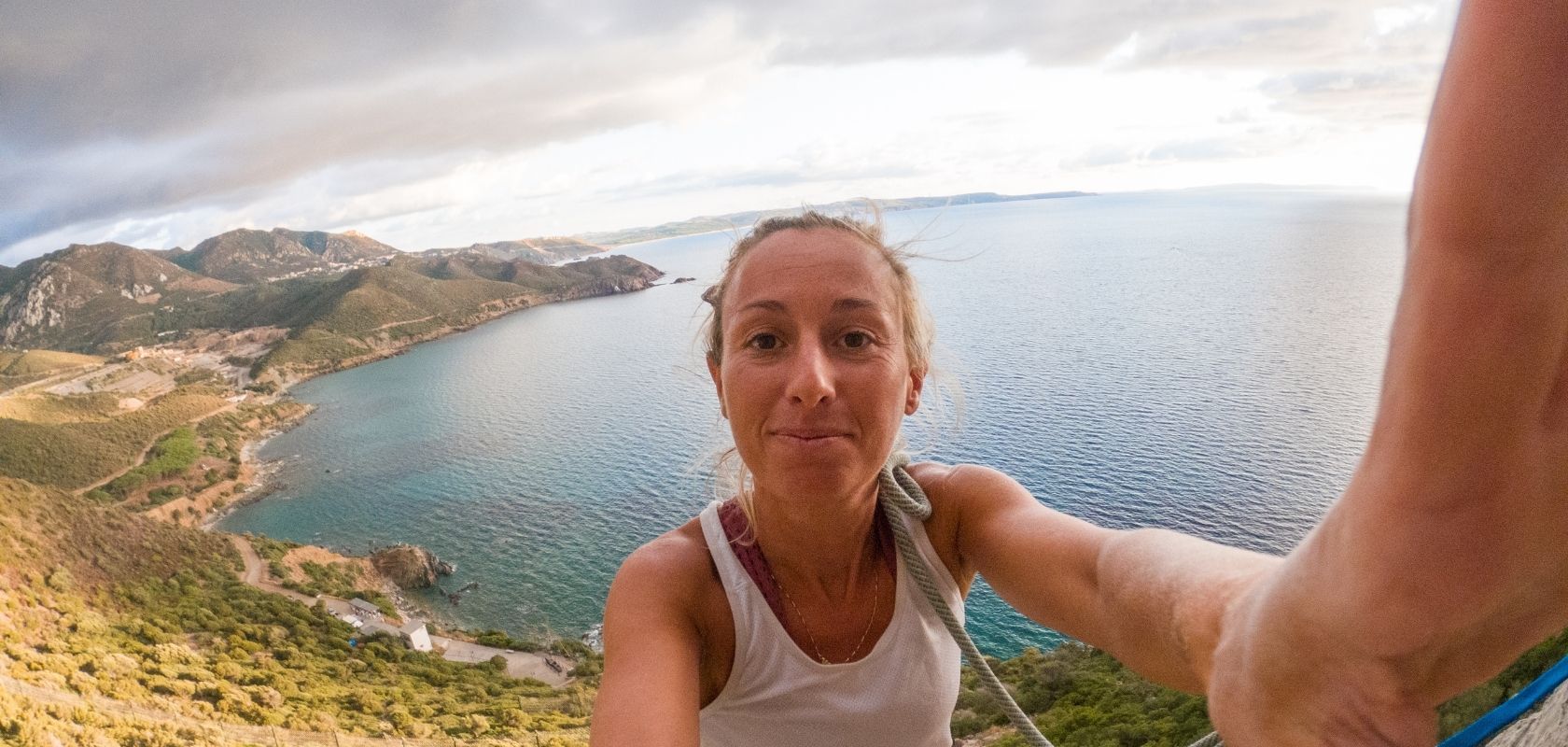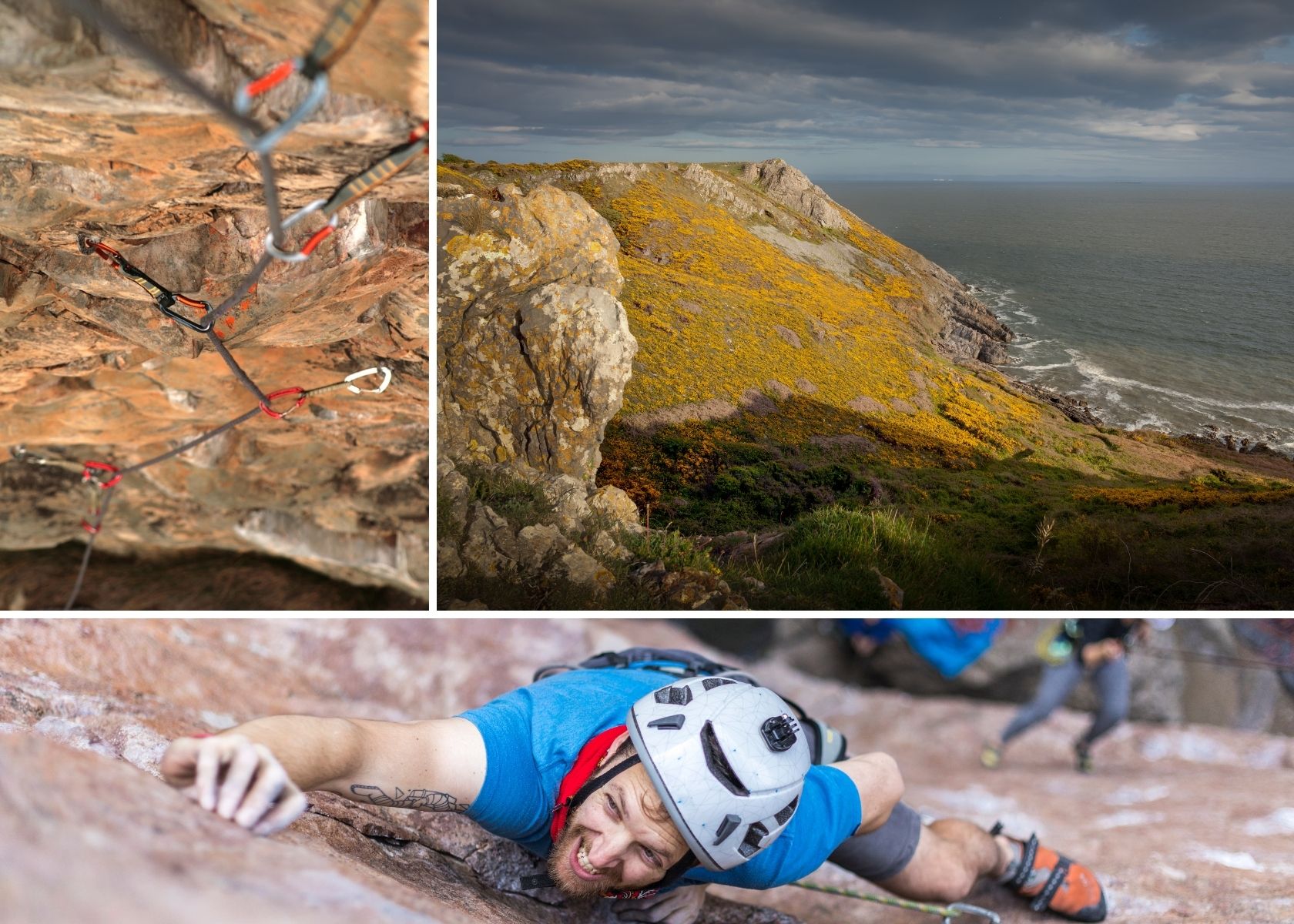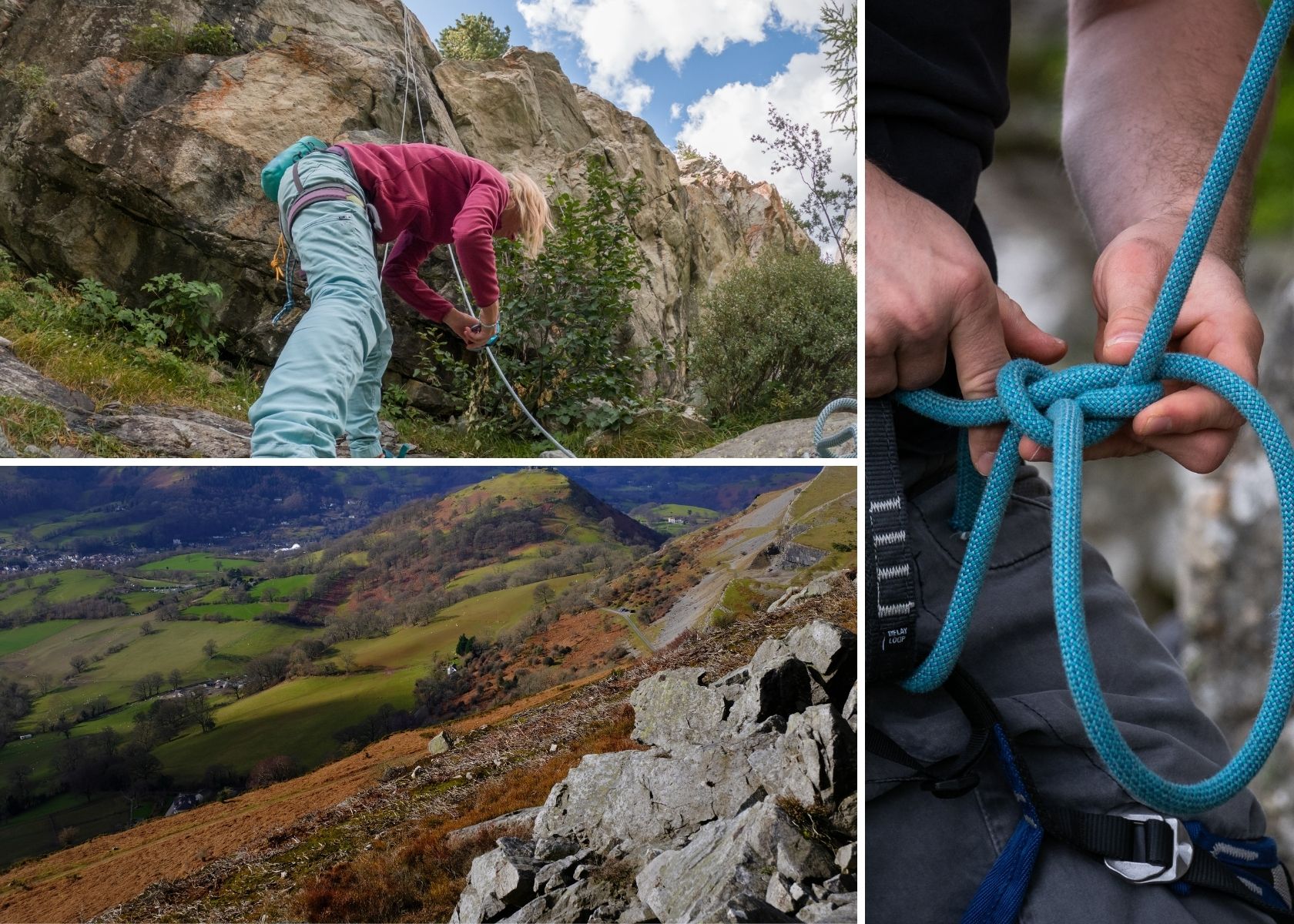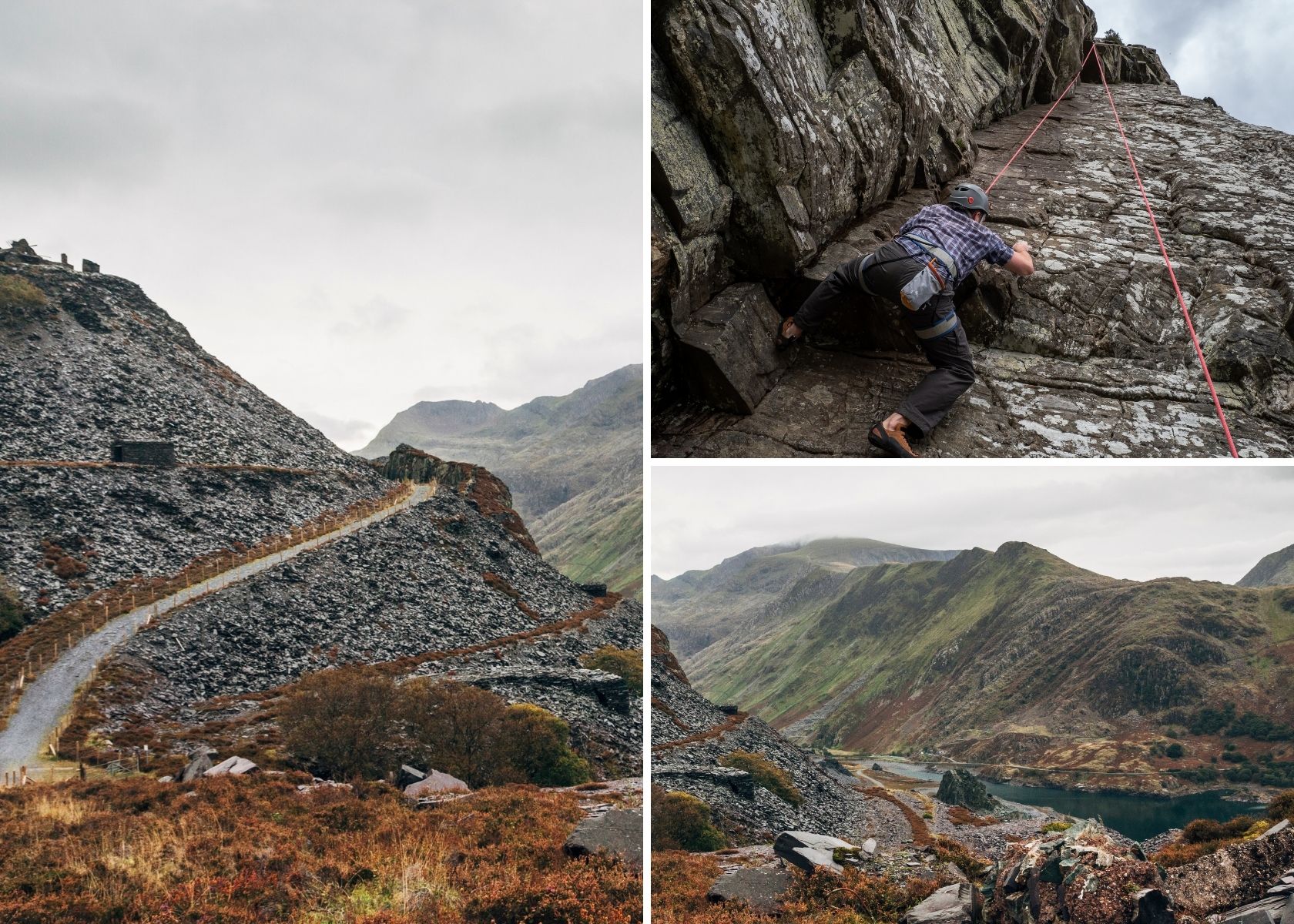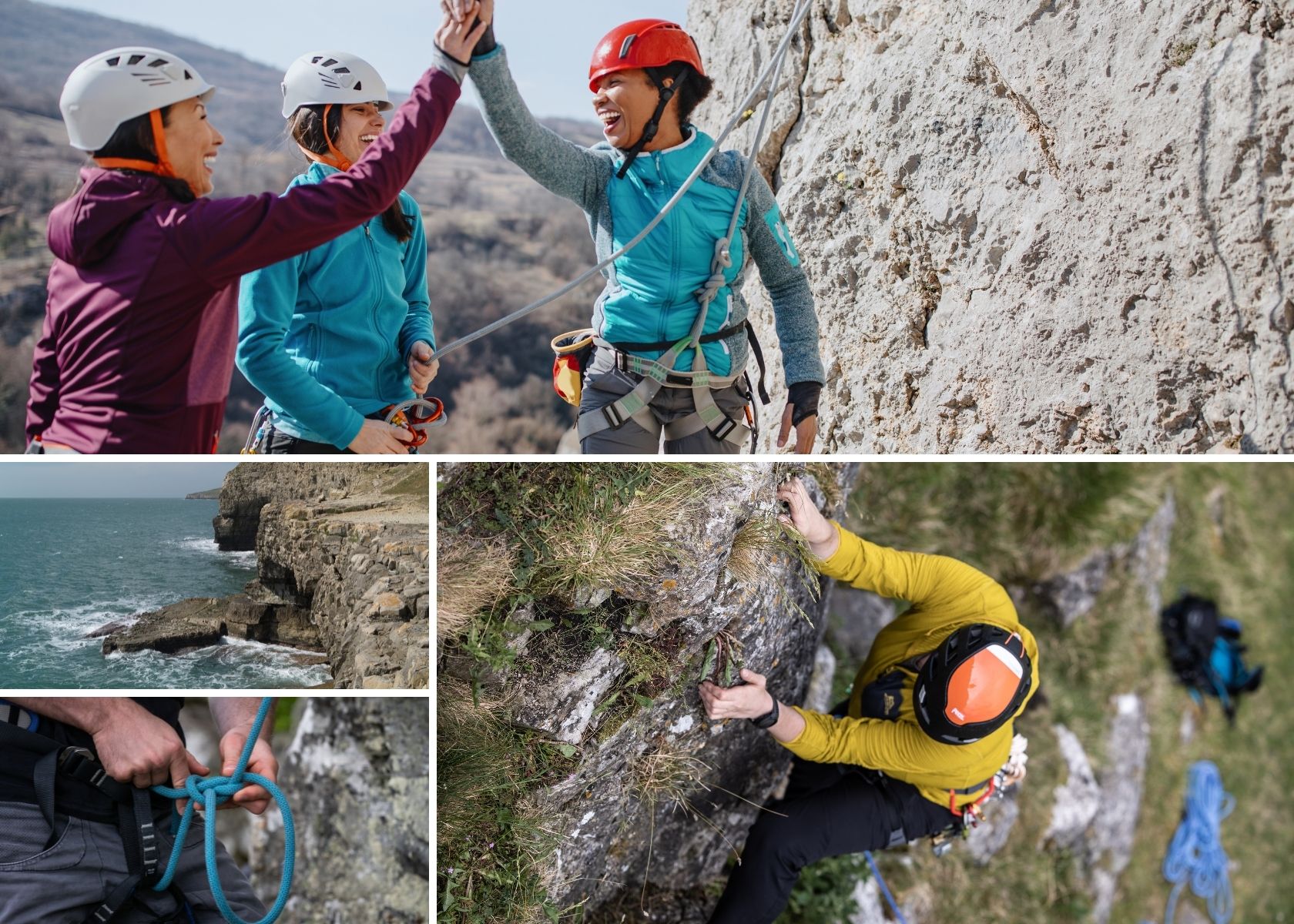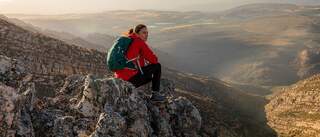THE BEST UK LOCATIONS TO UP YOUR SPORT CLIMBING GAME
If you’ve recently got into climbing, particularly sport climbing, and have been waiting for an opportunity to get out and there and test your new skills, look no further. There are few who know more about climbing than the BMC, especially in the UK, so check out their top 10 best UK sport climbing destinations and start planning a summer on the wall.
Wyndcliffe Quarry
Nestled in the tranquil Wye Valley, Wyndcliffe Quarry is a classic spot for those looking to up their sport climbing game in the UK. The area is renowned for its peaceful woodland setting and the diversity of climbing styles it offers, all set against the backdrop of scenic limestone cliffs. The valley itself is a destination worth visiting, with a wide range of routes catering to different skill levels, making it a favourite for both beginners and those seeking a relaxed day on the rock.
Wyndcliffe Quarry stands out as a disused roadside limestone quarry, offering primarily slabby climbing in a sheltered woodland environment. This makes it particularly inviting on cold, dry days, as the trees provide some protection from the wind and the sun warms the south-facing rock. With nearly 60 recorded routes, the crag offers a roughly even split between traditional and sport climbing lines. The sport routes are mostly well-bolted and short, providing a safe and accessible introduction for those new to outdoor sport climbing. Around a dozen of these are graded between French 4 and 6a, making them ideal for those progressing from indoor walls or looking for a confidence boost outdoors.
For those considering a visit, here are the key details:
- Where: Tranquil Wye Valley, South Wales
- Parking: 200m up the road in a Forestry Commission car park; limited parking is also available at the base of the cliff
- Best for: Slabby, roadside climbs with easy access
- When to go: Cold, dry days are ideal, thanks to the sheltered aspect and sun exposure
- Grades: Sport routes from 3a to 7b, with a strong concentration in the 4 to 6a range; trad routes also available
- Route style: Mostly single-pitch, short, and beginner-friendly; some descents may require abseiling from cliff top trees
- Atmosphere: Can get busy due to its popularity with beginners, but still offers a peaceful woodland vibe and a straightforward climbing experience
Wyndcliffe Quarry is a solid choice for climbers seeking a mix of trad and sport routes in a beautiful, easily accessible setting. Whether you’re just starting out or looking for a relaxed day of climbing, this crag delivers a quintessential Wye Valley experience.
Gower: Southgate Area
The Southgate area on the Gower Peninsula is a captivating climbing destination, known for its complex mix of stunning sea cliffs, caves, and sheltered bays along the south Gower coast. This area comprises several distinct climbing crags, all within a short walk from the National Trust car park in the quaint village of Southgate. The natural beauty of the setting is complemented by superb nearby beaches and a highly recommended café and cake shop perched near the cliff tops, making it an inviting spot for climbers and visitors alike.
One of the highlights for climbers seeking easier grades is Watch House slab, a non-tidal crag that dries quickly after rain, offering reliable conditions. However, some other crags in the Southgate area are tidal, so it is essential to consult tide tables carefully to avoid being caught out by rising water or getting wet feet. The climbing here spans a broad range of grades, with a strong focus on sport routes, making it ideal for climbers looking to progress in a scenic coastal environment.
Key features of Southgate include:
- Where: The stunning Gower coast, South Wales
- Parking: Southgate National Trust car park, just minutes from the climbing areas
- Best for: A variety of climbing styles, including sport and trad, in an exquisite seaside setting
- When to go: Very sheltered and pleasant even on cold winter days, making it a year-round destination
- Climbing style: Mix of sport and trad routes; Watch House slab is non-tidal and great for easier grades
- Grades: Routes range from beginner-friendly grades (around F4/F5) up to challenging climbs (F8b)
- Additional perks: Nearby beaches and a café provide a perfect place to relax after climbing
- Tide awareness: Some crags are tidal; studying tide tables is crucial for safe access
The Southgate area is widely regarded as the best selection of sport climbs on the Gower Peninsula, with multiple crags close together allowing climbers to sample a variety of routes in one day. Its sheltered location and full sun exposure make it a "slabby winter paradise," especially suited for climbers operating in the 4 to 6a grade range. The combination of beautiful sea views, diverse climbing options, and convenient amenities ensures Southgate remains a top choice for climbers aiming to elevate their sport climbing experience in the UK.
Horseshoe Quarry
Horseshoe Quarry is one of the premier destinations for sport climbing in the Peak District, especially for those operating in the lower to mid-grade range. This large, disused limestone quarry is located near Stoney Middleton and is renowned for its accessibility, quick-drying rock, and sheltered setting, making it an ideal venue for both cold days and warm summer evenings. The quarry’s open, flat landscape means there’s plenty of space, and the renaturalised surroundings add to its appeal.
The heart of the action is the Main Face, where you’ll find the best concentration of high-quality sport routes. For those just starting out or looking for easier climbs, the Upper Tier offers a wealth of introductory lines. The quarry boasts over 100 bolted routes, with the majority falling between French grades 6a and 7b, but there’s also a solid selection of easier climbs from 3a upwards. This makes Horseshoe Quarry a hub for progression, whether you’re moving from indoor walls to outdoor sport or looking to push your grade in a supportive environment.
It’s important to note that, as with many old quarries, some loose rock remains—so wearing a helmet is strongly advised, and care should be taken not to belay directly beneath the climber. Access couldn’t be simpler: a well-surfaced path leads from the small car park just off the A623 to the climbing areas in only a few minutes.
Key details for planning your visit:
- Where: In the heart of the Peak District, near Stoney Middleton
- Parking: Small car park just off the A623, with a short, easy approach
- Best for: The centre of lower to mid-grade sport climbing in the Peak District
- When to go: Colder days and summer evenings; the quarry is quick-drying and gets good afternoon sun
- Grades: Extensive range from 3a to 7b, with a strong focus on 6a–7a routes
- Climbing style: Single-pitch, bolted sport climbing; some trad and multipitch options available
- Rock quality: Mostly solid, but some loose sections—helmet recommended
- Atmosphere: Can be busy due to popularity, but the large open space prevents it feeling crowded
- Other tips: The most popular routes are on the Main Face; the Upper Tier is great for beginners and easier climbs
With its combination of easy access, reliable conditions, and a huge variety of routes, Horseshoe Quarry remains a must-visit for anyone looking to up their sport climbing in the UK.
Trevor Rocks
Trevor Rocks offers a truly stunning climbing experience overlooking the Upper Dee Valley above Llangollen in North East Wales. This old limestone quarry features over 150 climbing routes spread across more than ten separate climbing walls on a south-facing escarpment. The location provides breathtaking views of the remains of Dinas Bran castle, a medieval Welsh fort, adding a historic and picturesque backdrop to your climbing session. The variety of routes makes it suitable for every aspiring sport climber, with mostly single-pitch climbs ranging from easier to mid grades.
The crag is well known for its easy-angled climbs and excellent sun exposure, making it a perfect spot for climbing on sunny days. However, it is very exposed, so it’s advisable to avoid visiting on cold or windy days. The left side of the cliff is sometimes home to nesting peregrine falcons, which may lead to temporary access restrictions during spring and early summer, although currently no seasonal restrictions are in place. Climbers should always respect any signage and conservation rules, as the area is designated both as an SSSI and a European Special Area of Conservation.
Key information for visiting Trevor Rocks:
- Where: Overlooking the picturesque Upper Dee Valley near Llangollen, North East Wales
- Parking: Parking area located on a hairpin bend on the Panorama Drive above Llangollen
- Best for: Amazing views combined with a wide variety of easy-angled sport climbs
- When to go: Sunny days are ideal; avoid cold, windy conditions due to the crag’s exposed nature
- Climbing style: Mostly single-pitch sport routes with some trad options; a mix of lower and mid-grade climbs
- Routes: Over 150 routes spread across multiple walls, suitable for all levels
- Wildlife considerations: Peregrine falcons may nest on the left side of the cliff; check for access restrictions in spring/early summer
- Conservation status: The area is protected, so no new route development or rock clearing is permitted
Trevor Rocks is not only a fantastic climbing venue but also a place to enjoy spectacular views and the rich natural and historical heritage of the Dee Valley. Its combination of accessible sport routes, scenic surroundings, and conservation importance makes it a standout location for climbers looking to improve their skills while soaking in one of Wales’s most beautiful landscapes.
Castle Inn Quarry
Castle Inn Quarry is arguably the most roadside-friendly crag in North Wales, with limestone walls rising directly above the car park near Colwyn Bay and just off the A55 expressway. This unbeatable accessibility makes it a favourite for quick sessions or spontaneous climbing days. The quarry is often drenched in sunshine, even when the nearby peaks of Snowdonia are shrouded in cloud, making it a reliable choice for good weather. However, it can feel chilly on windy days, though the rock dries rapidly after rain, ensuring plenty of climbable days throughout the year.
The main crag offers a selection of well-bolted, clean, and slabby to off-vertical sport climbs, making it especially popular with beginners and those looking to build confidence on lead. The right wing of the main face is particularly useful for novice leaders, featuring over a dozen routes below grade 5. The quarry’s setting is also a draw: the top of the crag is part of the Mynydd Marian Nature Reserve, a haven for rare butterflies and heathland flowers, offering a unique blend of climbing and nature.
Key details for your visit:
- Where: Mynydd Marian Nature Reserve, near Colwyn Bay, North Wales
- Parking: Directly below the crag—no approach walk required
- Best for: Slabby and off-vertical easy sport climbs, ideal for beginners and group sessions
- When to go: Sunny days are perfect; bring a picnic and enjoy the views, but avoid windy weather as the crag is exposed
- Grades: Many routes in the low to mid grades, with a strong selection below French 5—great for novice leaders
- Climbing style: Almost exclusively sport climbing, with well-bolted and clean lines
- Nature: The crag sits within a nature reserve, so you can combine climbing with wildlife spotting and wildflower walks
Castle Inn Quarry is a top pick for accessible, beginner-friendly sport climbing in North Wales, offering a sunny, scenic, and sociable venue just minutes from the car. Its combination of easy routes, quick-drying rock, and nature reserve setting make it a must-visit for anyone looking to up their sport climbing in the UK.
The Cuttings
The Cuttings is one of the most popular inland sport climbing venues in the south of the UK, perched above Weymouth Bay on the Isle of Portland, Dorset. Set in an old railway cutting, the crag features several vertical limestone walls that rise directly from a flat, clear base—making it easy to gear up and relax between climbs. The climbing here is highly varied, with routes demanding a mix of finger strength and technical skill, and the crag’s sheltered aspect means it’s often in good condition when other Portland spots are damp or windswept. While The Cuttings can be hot in high summer, it’s an excellent choice for morning sunshine or evening shade, and in colder months, it can be pleasantly warm when much of the UK is cold and wet.
The crag is renowned for its wide spread of grades, making it a true all-rounder. There are over 180 bolted sport routes, from friendly beginner climbs in the Bonsai Area to technical, sustained testpieces for experienced climbers. The bolting is generally friendly, though some of the easiest routes can be polished and are not always ideal for learning to lead. The Cuttings is also home to a massive boulderfield, offering hundreds of problems for those keen to mix up their climbing day.
Key details for visitors:
- Where: The sport climbing mecca of Portland, Dorset, overlooking Weymouth Bay
- Parking: Church Ope car park near the Mermaid Inn in Easton; a short walk via the Portland Museum and coast path leads directly to the crag
- Best for: Vertical limestone climbing with a huge range of grades and styles, from slabs to technical walls and cracks
- When to go: Ideal for morning sun or evening shade; avoid the midday heat in summer, but enjoy warm conditions on sunny winter mornings
- Grades: Routes from French 3 to 8a, with a strong selection in the 5s and 6s; a dedicated beginners’ sector (Bonsai Area) is available, though some routes are polished
- Climbing style: Technical and sustained sport climbing on quarried limestone; bouldering also available in the extensive Cuttings Boulderfield
- Atmosphere: Busy at peak times, but the crag’s size means there’s always something to do; quieter sectors can be found with a short wander
- Other tips: The flat base is perfect for groups and picnics; the crag dries quickly after rain and is sheltered from prevailing winds
The Cuttings stands out as a must-visit for sport climbers of all abilities, combining easy access, reliable conditions, and a huge variety of routes in one of the UK’s premier climbing destinations.
Dinorwig Slate Quarries: Australia Area
The Australia Area of Dinorwig Slate Quarries in Llanberis, Snowdonia, is a legendary destination for those looking to experience the unique challenge of slate climbing. Slate is unlike any other climbing rock in the UK: it demands precise footwork, excellent balance, and strong fingers. The climbing is technical and often puzzling, with small edges and crimps being the norm. The vast, abandoned quarries create a surreal, dramatic landscape—steep terraced levels, echoing industrial history, and panoramic mountain views—making every visit memorable.
The Australia sector is one of the largest and most popular areas in the Dinorwig complex. Here, you’ll find over 50 bolted sport routes on slabby, terraced walls, with grades ranging from accessible to challenging. The area is especially known for its concentration of easier sport climbs, making it a good entry point for those new to slate, though the style will test even experienced climbers. The rock dries quickly after rain, but the quarry is cold and exposed in winter, so it’s best visited in warmer months.
Access is straightforward: park near the bus turnaround in Dinorwig village and follow the public footpath into the quarry. However, it’s important to note that the land is privately owned by a power generation company, and climbing is only tolerated if you stick to established paths and respect the area.
Key details for visiting the Australia Area:
- Where: Abandoned slate quarry in Llanberis, Snowdonia
- Parking: Near the bus turnaround in Dinorwig village; free roadside parking is usually available
- Best for: Slabby sport climbing, technical footwork, and experiencing a dramatic post-industrial setting
- When to go: Avoid winter (very cold); the rock dries quickly after rain, making it a good choice in changeable weather
- Climbing style: Technical sport climbing on slabs and terraces, with a focus on balance and precision
- Routes: Over 50 bolted sport routes, including some of the best easy sport climbs in the quarries
- Grades: Broad range, with many routes in the F5–F7a bracket; some trad lines and multi-pitch link-ups also available
- Atmosphere: Surreal, atmospheric, and historic; the area is vast, so it rarely feels crowded
- Access notes: Technically on private land—stick to marked footpaths and be respectful of the site’s sensitive status
- Other tips: Be prepared for loose slate underfoot and occasional water-filled holes after rain; bring a brush or rag to clean holds if needed
Climbing in the Australia Area is as much about the experience as the routes themselves. The combination of unique slate movement, industrial history, and sweeping Snowdonia views makes it a must-visit for any sport climber looking to broaden their horizons in the UK.
Castlebergh Crag
Castlebergh Crag is a remarkable urban climbing venue that towers just above the centre of Settle in Yorkshire. Until 2009, it was largely ignored by climbers, who assumed that its proximity to the town centre meant climbing wouldn’t be allowed. That changed after a rockfall drew attention to the crag, sparking a unique collaboration: the local council funded a major clean-up and development project, and local businesses even bought the naming rights to new routes. The result is a superb, south-facing limestone crag that’s now a favourite spot for local and visiting climbers alike.
The crag offers a selection of 24 fully bolted sport climbing routes, mostly in the 4+ to 6a+ range, with a handful of harder lines for those looking to push themselves further. The routes are predominantly on steep, vertical limestone, providing engaging climbing just a short walk from Settle’s cafes and shops. While the area has been extensively cleaned, some loose rock remains, so wearing a helmet is strongly recommended for all climbers.
Castlebergh is especially attractive for its easy access and sheltered setting, making it a good choice on windy days. The approach is a straightforward uphill walk from Settle’s public car parks, and the base of the crag is flat and suitable for groups or families.
Key details for your visit:
- Where: Just above Settle town centre, Yorkshire Dales
- Parking: Use public car parks in Settle; the crag is a short walk uphill
- Best for: Steep, well-bolted sport routes and unbeatable town-centre access
- When to go: A sheltered venue, ideal when it’s windy elsewhere
- Grades: Majority of routes are 4+ to 6a+, with a few harder options
- Climbing style: Vertical to steep limestone, mostly sport climbing; some bouldering also available
- Atmosphere: South-facing and sunny, with great views over Settle
- Safety: Some loose rock remains—helmets are advised
- Other tips: The crag is family-friendly and close to local amenities; check for any temporary access restrictions due to nearby building works
Castlebergh Crag stands out for its unique history, community-driven development, and urban convenience—a must-visit for anyone looking to combine quality sport climbing with the charm of a Yorkshire market town.
Llanymynech
Llanymynech Quarry is a dramatic limestone quarry straddling the border between England and Wales, near Oswestry in Shropshire. This extensive site is best known for its adventurous, long sport climbing routes—offering a real sense of exposure and commitment. With over 100 sport routes spread across several different faces, Llanymynech is a destination for climbers seeking a challenge and variety. The routes are predominantly vertical or steep, with many lines stretching up to 55 metres, making it a true test of endurance and rope management.
This is not a crag for absolute beginners; the climbing is generally best suited to those with some outdoor experience already. The majority of sport climbs fall within the 6b to 7b range, though there are also a handful of easier and harder lines, as well as some excellent traditional routes for those looking to mix things up. The adventurous character of the quarry is heightened by its setting as a nature reserve, managed by the Shropshire Wildlife Trust. Climbers are asked to respect the environment and adhere strictly to seasonal restrictions for nesting birds: all routes on the Red Walls are closed from 1 March to 30 June, and Foreigner Wall is permanently restricted.
Access is straightforward, with parking available at the Shropshire Wildlife Trust car park in the village of Llanymynech. From there, a short walk leads to the quarry and its various sectors. The site is shared with walkers and wildlife enthusiasts, so considerate behaviour is essential to maintain ongoing access.
Key details for climbing at Llanymynech:
- Where: On the England–Wales border, near Oswestry, Shropshire
- Parking: Use the Shropshire Wildlife Trust car park in Llanymynech village
- Best for: Long, adventurous, vertical and steeper sport routes—many up to 55m in length
- Grades: Strong concentration of sport climbs from 6b to 7b, plus some easier and harder options; also a handful of quality trad lines
- Climbing style: Adventurous sport climbing, with multi-pitch classics and a few traditional routes
- Atmosphere: Dramatic quarry setting, with a wild and exposed feel
- Restrictions: Red Walls closed 1 March–30 June for nesting birds; Foreigner Wall permanently restricted—check signage on site
- Nature: The quarry is a designated nature reserve, so take care not to disturb wildlife or damage vegetation
- Suitability: Best for experienced sport climbers; not recommended for novices
Llanymynech stands out for its lengthy, adventurous sport routes and its impressive, wild setting. It’s a must-visit for those looking to push themselves on some of the most dramatic limestone climbing the UK has to offer.
Dancing Ledge
Dancing Ledge is one of the most popular and easily accessible climbing venues on the Jurassic Coast near Swanage, Dorset. Its unique location by the sea offers climbers the chance to enjoy non-tidal sport climbing on limestone, with stunning coastal views and a flat base right by the water. The crag is known for its roughly 100 bolted routes, catering to a wide range of abilities—from challenging hard climbs to easier routes suitable for beginners looking to gain experience outdoors. This variety, combined with quick access from a free car park near Langton Matravers, makes it a favourite spot for locals and visitors alike.
The climbing at Dancing Ledge is mostly steep and technical, demanding good finger strength and precise footwork. However, some of the routes graded in the 5s and 6s have become polished over time due to heavy foot traffic, making them feel harder than their grades suggest. Aside from climbing, the site has an interesting historical feature: a small tidal pool was blasted into the rock about 100 years ago for local schools. While not large enough for swimming, it provides a refreshing spot to cool down after a climb on hot days.
Key points about Dancing Ledge:
- Where: By the sea in beautiful Dorset, near Swanage
- Parking: Free car park at map reference SY 998767, close to Langton Matravers village
- Best for: Easily accessible, non-tidal sport climbing with a wide range of grades
- When to go: Out of peak season for quieter conditions; mornings and evenings are ideal to avoid the summer heat
- Routes: Approximately 100 bolted sport climbs, from beginner-friendly to very hard, mostly on steep limestone
- Climbing style: Technical and steep sport routes; some polished holds on popular easier climbs
- Additional features: Historic tidal pool for cooling off; flat base area suitable for groups and picnics
- Atmosphere: Busy in summer but spacious enough to avoid overcrowding; great coastal views enhance the experience
- Tips: Be mindful of polished routes; bring sun protection and water for hot days
Dancing Ledge combines spectacular coastal scenery with a broad spectrum of sport climbing, making it an ideal venue for climbers looking to improve their skills in a scenic and accessible setting on the UK’s south coast.
Produced in partnership with the BMC.
Snow+Rock are proud to offer BMC members 15% off in-store and online.


Let us know you agree to cookies
We use marketing, analytical and functional cookies as well as similar technologies to give you the best experience. Third parties, including social media platforms, often place tracking cookies on our site to show you personalised adverts outside of our website.
We store your cookie preferences for two years and you can edit your preferences via ‘manage cookies’ or through the cookie policy at the bottom of every page. For more information, please see our cookie policy.

